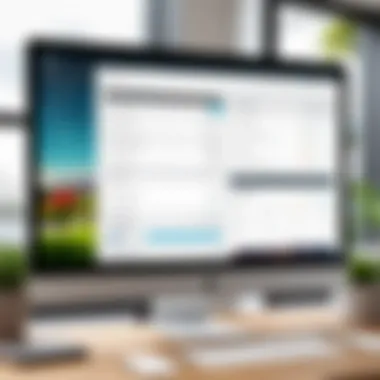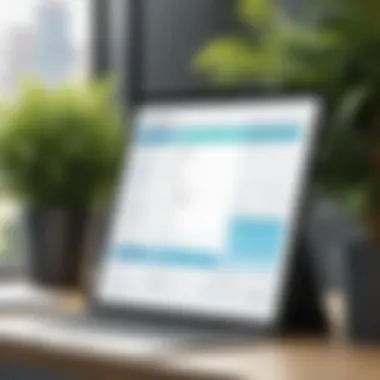Top Invoice Software for Landscaping Professionals


Intro
In the landscaping industry, effective invoicing is crucial for maintaining cash flow and ensuring the business runs smoothly. Choosing the right invoice software is an essential decision for landscaping professionals. This guide aims to provide insights about the best invoice software tailored specifically for landscapers. The focus will be on core features, user experience, and pricing structures, which are fundamental to making an informed choice.
Overview of Core Features
When selecting invoice software, certain functionalities are paramount for landscaping businesses. These features enhance efficiency in billing processes and improve overall management.
Description of essential functionalities
- Customizable Templates: The ability to create invoices that represent your brand is vital. Good software provides customizable templates that allow for logos, colors, and specific terms related to landscaping services.
- Itemized Billing: For landscaping, itemizing services such as lawn mowing, tree trimming, or landscaping design helps clients understand charges clearly. This transparency fosters trust.
- Time Tracking: Some software includes time tracking features that allow landscapers to log hours spent on different projects directly into the invoice. This saves time and ensures accuracy in billing.
- Mobile Accessibility: Landscaping often requires working in different locations. Software that offers mobile access enables invoicing on the go, which is advantageous for landscaping teams.
- Payment Processing Integration: Having integration with payment processing platforms streamlines the payment collection process. Accepting credit cards or digital payments can significantly speed up cash flow.
Comparison of features across top software options
Several software options cater to the landscaping industry. Here’s a brief comparison of some leading providers:
| Software | Customization | Time Tracking | Mobile Access | Payment Processing | | FreshBooks | Yes | Yes | Yes | Yes | | QuickBooks | Yes | Limited | Yes | Yes | | Square Invoices | Yes | No | Yes | Yes | | Invoice Ninja | Yes | Yes | Yes | Yes |
This comparison highlights that while all software offers essential features, some excel in specific areas like tracking or customization.
User Experience and Interface
User experience (UX) plays an important role in the efficiency of the invoicing process. Landscaping professionals often balance multiple tasks. Therefore, a user-friendly interface can minimize frustration.
Insights into UI/UX design aspects
An ideal invoice software solution should have a clean layout, easy navigation, and intuitive controls. Users should be able to create, edit, and send invoices in just a few clicks. Positive design elements include clear labeling, visual hierarchy, and consistent terminology throughout the software.
Importance of usability and accessibility
Usability is key for professionals who may not be tech-savvy. A step-by-step guide or assistance feature can enhance the experience. Additionally, accessibility is crucial; software that works well on different devices ensures that landscapers can manage invoicing from any location.
The right invoicing software not only automates billing but also enhances professional image and operational efficiency for landscaping businesses.
Understanding the Importance of Invoice Software in Landscaping
In the landscaping industry, where tasks vary from simple lawn maintenance to comprehensive landscaping projects, managing finances efficiently becomes paramount. Invoice software serves as a key tool that enhances the billing process, allowing professionals to focus more on their craft rather than administrative tasks.
Using invoice software provides several advantages, helping enterprises streamline financial operations. Firstly, it automates invoicing, which reduces human error. Manual billing is tedious and prone to mistakes that can directly affect cash flow. An effective invoicing software can ensure that invoices are generated accurately and promptly.
Another significant advantage is improved management of client information. Landscaping projects often involve various clients, each with unique needs and preferences. Invoice software allows professionals to store and easily retrieve client details, project history, and payment records, fostering better customer relationships.
Additionally, this software can integrate seamlessly with accounting tools, creating a cohesive financial management ecosystem. By capturing expenses and revenues in one unified platform, landscaping professionals can gain valuable insights into their financial health. With accurate and organized financial data, business owners can make informed decisions regarding future projects, budget allocation, and even growth strategies.
"Effective invoicing software is not just a tool; it is a strategic ally that promotes financial health in the landscaping business."
In summary, the importance of invoice software in landscaping cannot be overstated. It enhances efficiency, minimizes errors, supports organizational needs, and ultimately contributes to a more profitable business.
Defining Invoice Software
Invoice software is a digital application designed to create, send, and manage invoices electronically. It serves as a structured platform where businesses can automate billing processes. Users can customize invoice formats, generate invoices with calculated totals, and track payments. The software also aids in recurring billing, which is beneficial for landscaping services that offer ongoing maintenance contracts.
Typically, these software solutions come with templates to make the process quicker and easier. They allow users to input data such as client names, services rendered, and payment terms. By standardizing invoices, landscaping professionals can maintain a consistent and professional appearance in their communications.


Benefits for Landscaping Professionals
The benefits of invoice software extend beyond mere automation. One notable advantage is time savings. Landscaping professionals often juggle multiple tasks, from design to implementation. Having reliable invoice software can dramatically cut down the time spent on billing, allowing for a better focus on operational excellence.
Another key benefit is the enhanced visibility into cash flow. By examining real-time data on payments, overdue invoices, and pending transactions, landscaping businesses can manage their finances more effectively. This insight aids in maintaining healthy cash flow, which is crucial for every business's sustainability.
Furthermore, many invoice software solutions offer mobile access. This flexibility means that landscaping professionals can manage invoices on-site, generating them as soon as a project is completed. This immediacy not only improves cash flow but also boosts customer satisfaction, as clients receive prompt and professional follow-ups after service completion.
Lastly, the integration capabilities of invoice software with other business applications – from CRM to accounting systems – create a more efficient workflow. This interconnectedness streamlines operations, providing a holistic view of business performance while minimizing duplicate data entry across platforms.
Key Features to Look for in Invoice Software
When considering invoice software for landscaping, it is vital to focus on certain key features. These features can greatly impact how effectively a landscaper can manage their invoicing processes. The right features not only enhance efficiency but also enable better financial management. Here are some of the most crucial elements to look for:
User-Friendly Interface
A user-friendly interface is essential for any invoice software. Landscaping professionals often have busy schedules, which means they need software that is easy to navigate. A clean layout with intuitive navigation reduces the learning curve significantly. Users should be able to create and send invoices with minimal clicks. Therefore, features like drag-and-drop functionality for adding services and clear labeling on buttons enhance usability. The design should also be mobile-responsive, allowing users to manage invoices from any device without compromise in functionality.
Customizable Templates
The ability to customize templates is an important feature that landscaping businesses should not overlook. Every company has its own branding which should be reflected in its invoices. Customizable templates allow the inclusion of company logos, colors, and specific service descriptions. This can contribute to a professional appearance and reinforce brand identity. Most software solutions offer templates that can be modified easily, enabling users to maintain a consistent look for all client communications. Moreover, incorporating specific services and materials into these templates can simplify the invoicing process.
Automated Billing Systems
Automated billing systems play a significant role in enhancing cash flow management. This feature allows users to set schedules for recurring invoices. For landscaping services that provide ongoing maintenance, this feature can be especially useful. Automated reminders for overdue payments can also help ensure timely collections. Eliminating the need for manual invoice generation and follow-ups saves time and reduces errors. Thus, investing in software with strong automated billing capabilities can lead to improved efficiency and quicker payments.
Integration with Accounting Tools
Integration with accounting tools is another critical feature. Many landscaping businesses already use accounting software like QuickBooks or Xero. The ability to sync data between invoice and accounting software can reduce the need for duplicate entry, minimizing errors. Seamless integration makes it easier to manage finances, track expenses, and generate financial reports. Having a holistic view of one’s financial situation is paramount for informed decision-making. Hence, selecting software that easily integrates with existing accounting systems is advisable.
Top Invoice Software Options for Landscaping
Understanding the landscape of invoice software options specifically tailored for landscaping is vital for both efficiency and professionalism. Landscaping professionals often juggle multiple tasks, from client communication to project management, making appropriate software an essential tool. The right invoicing solution can streamline billing processes, minimize errors, and enhance cash flow management.
Overview of Leading Software
In the market today, a variety of invoice software options cater to the landscaping industry. Some of the most notable options include FreshBooks, QuickBooks, and Jobber. Each of these platforms offers distinct features that can be advantageous for landscaping businesses. For example, FreshBooks emphasizes simplicity and offers invoicing as well as expense tracking. QuickBooks, known for its comprehensive accounting features, integrates seamlessly with a host of business tools. Jobber focuses on field service management functions and is designed specifically for service-based industries like landscaping.
Comparative Analysis
Feature Set Comparison
The feature set of any invoice software is critical for accomplishing a landscaping business's goals. Key features often include customizable templates, automated billing, and robust reporting capabilities. For instance, customizable templates allow businesses to maintain brand consistency and present professionalism in their invoices. Features like automated billing can save landscaping companies time, allowing them to focus more on projects rather than paperwork. This makes feature sets a significant component in choosing software, as their strengths directly impact the efficiency of invoicing practices.
Pricing Structures
Pricing structures are essential to consider when evaluating invoice software. Many platforms offer tiered pricing, which can cater to different business sizes and needs. For example, FreshBooks operates on a subscription model that varies based on the number of clients served. QuickBooks also provides various plans, making it accessible for both small businesses and larger firms. Understanding these pricing structures helps businesses to budget effectively, ensuring they select a solution that aligns with their financial capabilities while still meeting their operational needs.
User Experience Insights
User experience is often overlooked but plays a significant role in software selection. Software that is easy to navigate can lead to greater efficiency and less frustration over time. For instance, Jobber is praised for its intuitive interface, allowing users to quickly generate invoices on the go, which is beneficial for landscaping teams that work off-site. Conversely, some users may find comprehensive platforms like QuickBooks overwhelming due to the breadth of features offered. Therefore, knowing how user experience affects day-to-day operability is essential when selecting invoice software.
User Reviews and Case Studies


User reviews and case studies play a crucial role in understanding the effectiveness of invoice software tailored for landscaping. They offer insights that go beyond the technical specifications and features listed by the providers. By examining feedback from actual users, potential buyers can gauge a software's reliability and actual usability in real-world scenarios. Thus, gathering and analyzing user reviews is a vital step for both decision-makers and practitioners in the landscaping industry.
Real-World Applications
In landscaping, invoicing software must adapt to practical needs in various situations. Users often share experiences that highlight how the software addresses specific challenges, such as managing client requirements, tracking expenses, and creating invoices efficiently. For instance, a landscaping business might report that they successfully reduced their billing time by half after implementing a new software solution. This important feedback allows potential users to visualize how a software can streamline their processes and improve customer relations.
Additionally, case studies can demonstrate how different landscape firms have benefited from specific software features. For example, a case study may show how automated billing reduced errors and late payments for a landscaping company working with multiple clients.
This knowledge is crucial, as it helps businesses make informed decisions based on others' experiences and provides validation of the software's claims about efficiency and functionality.
Customer Feedback
Customer feedback is an invaluable resource when choosing invoice software. Many prospective users look for detailed opinions on various aspects, such as usability, customer support, and overall satisfaction. Positive reviews often highlight software that integrates smoothly with other tools, making the billing process seamless. Conversely, negative feedback can show potential pitfalls, like compatibility issues or lack of features necessary for daily operations.
A detailed analysis of reviews reveals trends in user preferences and needs, and it can guide which features might be essential for a business's specific operations. For example, if multiple users emphasize the importance of customizable invoicing templates, it hints that this feature could be critical for many landscaping businesses.
"The right software can elevate your billing process and enhance customer satisfaction. The real stories of other users validate this notion and provide direction for your investment."
Cost Considerations in Invoice Software
When selecting invoice software for landscaping businesses, cost considerations play a pivotal role. The right software can enhance efficiency, streamline operations, and ultimately improve financial management. Therefore, understanding the costs associated with different software options is essential for making informed decisions.
A well-structured budget is pertinent. This involves recognizing not just the initial purchase or subscription price, but also the long-term costs that may arise from using the software. Costs could include monthly fees, maintenance expenses, and potential upgrades. Moreover, there may be hidden costs like training for team members or integration with existing systems.
Understanding Pricing Models
Invoice software pricing models vary significantly across the market. Some software solutions use a one-time purchase model, where the software is bought outright and owned permanently. In contrast, subscription-based models are also common. These often include monthly or annual fees.
It's important to evaluate what features are included in these pricing structures.
- Free Versions: Some platforms offer free versions with basic functionalities. These may serve small businesses or startups but could limit growth and scalability.
- Freemium Models: These solutions offer basic services for free, with additional features available for a fee. This can be a way to assess software before making a substantial commitment.
- Pay-as-You-Go: This model allows users to pay based on actual usage, making it ideal for businesses with fluctuating invoicing needs.
- Tiered Pricing: Many software options adopt a tiered pricing model, where costs rise with increased features or the number of users. This can be beneficial for growing businesses as it aligns costs with needs.
Evaluating the cost of ownership is critical. It may be useful to assess how much time and resources each pricing model will save for your landscaping operations.
Budgeting for Software Solutions
Creating a budget for invoice software entails several steps. Begin with a comprehensive assessment of your business needs, including invoicing volume, the complexity of services offered, and team size. This understanding will guide the selection process, ensuring that the software meets the demands of your landscaping business.
It is also crucial to account for additional costs linked to the implementation of the chosen software:
- Training: Budget for educating your team on the new system, as this can affect productivity during the transition period.
- Support Fees: Some software platforms charge for support services. Continuous assistance may be necessary to maximize the benefits of the software.
- Integration Costs: If you use other software for accounting or project management, ensure your invoicing software can integrate without exorbitant costs.
- Future Upgrades: As your landscaping business grows, upgrade costs may arise. Consider a solution that scales with your needs without incurring prohibitive expenses.
In sum, budgeting for invoice software should extend beyond mere acquisition costs. A holistic approach, factoring in hidden costs and future needs, will pave the way for smarter financial management in your landscaping operations.
Implementation of Invoice Software
Implementing invoice software is a crucial step for landscaping businesses seeking to improve their billing processes. The use of appropriate software optimizes efficiency, reduces errors, and ensures timely invoicing. Without proper implementation, even the best software may not yield the desired results. It is therefore necessary to consider various elements and benefits that come from effective software deployment.
The importance of skilled implementation cannot be overstated. It influences how well the software integrates into existing workflows. Moreover, it can affect employee adoption rates, which is vital for maximizing the software’s potential. A well-implemented invoicing solution can significantly contribute to customer satisfaction, timely payments, and overall business growth.
Steps to Successful Implementation
- Assess Current Processes: Start by evaluating existing invoicing processes. Identify pain points and areas for improvement. This will help in selecting software that meets specific needs.
- Select Appropriate Software: Choose software that aligns with the unique requirements of the landscaping industry. Consider factors such as features and scalability.
- Create an Implementation Plan: Develop a clear roadmap for the implementation. This should include timelines, milestones, and assignment of responsibilities to team members.
- Test the Software: Before full rollout, conduct a pilot test with a small user group. This step can reveal issues and allow for adjustments before wider adoption.
- Monitor and Evaluate: After implementation, monitoring is essential. Regularly evaluate the software performance and gather feedback from users to make improvements where necessary.


Training and Support Resources
Training and support are integral to a successful software implementation. Ensuring that staff are fluent in using the new system can directly impact its effectiveness.
- Initial Training Sessions: Conduct comprehensive training sessions when the software is first introduced. This helps users become familiar with the interface and key functionalities.
- Ongoing Support: Establish a support system for users to report issues or ask questions. This could be in the form of a helpdesk, forums, or a dedicated support team.
- Documentation and Tutorials: Provide clear documentation and self-help resources. This allows users to access necessary information at their convenience.
"Training can make or break the successful implementation of invoice software. Well-informed users will utilize features correctly and enhance the invoicing workflow."
- Regular Updates and Workshops: As software evolves, offer regular updates and workshops to keep everyone informed about new features or changes.
By concentrating on these aspects, businesses can ensure their invoice software supports their operational needs effectively and enhances overall productivity.
Future Trends in Invoice Software for Landscaping
The landscape industry is notable for its dynamic nature, composed of various elements that shift with technological advancements and consumer expectations. In this context, understanding future trends in invoice software becomes crucial for professionals aiming to enhance their competitiveness. By being aware of these trends, businesses can adopt solutions that cater to evolving operational needs while improving efficiency in billing processes.
As the landscaping sector adopts more digital solutions, invoice software will not remain static. Innovations will likely streamline data management and improve customer interactions. Keeping abreast of these developments enables landscaping firms to select software that minimizes time spent on administrative procedures and maximizes time allocated to actual landscaping work.
Technological Advances
Technological progression continues to define modern business operations. In the realm of invoice software, several advances are shaping the tools available to landscaping professionals. The rise of cloud computing is at the forefront. This technology allows users access to their software from any location with Internet connectivity. It enables real-time data input and retrieval, making it far easier to manage invoices from job sites or client locations.
Moreover, mobile applications are becoming increasingly prevalent. Many invoice software providers now offer mobile interfaces. This allows for on-the-go invoicing, further increasing flexibility in billing procedures. Landscape professionals can bill clients immediately after a job is completed. This immediacy can significantly enhance cash flow, an essential component for business sustainability.
Another significant advancement is the incorporation of artificial intelligence. AI can analyze data patterns, assist in predicting incoming projects, and even suggest pricing models based on historical data. This not only optimizes invoicing but helps landscaping businesses make informed decisions about resource allocation.
Adapting to Changing Industry Needs
The landscaping industry is under constant pressure to adapt to changing consumer demands and regulatory landscapes. As clients become more environmentally conscious, there is a growing expectation for transparency in services provided. Invoice software can play a pivotal role here by incorporating features that detail materials used, labor hours, and any ecological considerations within a project.
Additionally, with an increasing number of consumers demanding digital-first experiences, software that allows for straightforward online payments becomes a requirement rather than an option. Businesses looking to stay competitive must consider invoice software that supports various payment gateways, facilitating smoother transactions.
Landscaping companies must also consider software that enables. Regular updates can help them comply with new industry regulations or changing tax laws. This ensures businesses maintain compliance and avoid potential legal complications.
Epilogue and Recommendations
In the context of the landscaping industry, understanding how to effectively utilize invoice software can significantly impact business operations. The choices made in selecting such software not only streamline billing processes but also enhance overall management efficiency. Given the challenges unique to landscaping services, such as variable job costs and client relationships, a careful assessment of features and functionalities is crucial.
The relevance of this conclusion and recommendations section lies in reinforcing the insights shared throughout the article. As discussed, key features such as a user-friendly interface, customizable templates, and integrations with accounting tools are fundamental to making the right choice.
Landscaping professionals should prioritize software that meets their specific needs while also being adaptable to future requirements. An informed decision involves understanding the underlying costs and ensuring proper implementation and ongoing evaluation of the software's performance.
Ultimately, investing time into selecting the most suitable invoice software does not just simplify billing; it can lead to improved cash flow and a stronger relationship with clients.
Final Thoughts on Choosing Software
Choosing the right invoice software requires more than just a glance at features. Professionals should consider their business size, expected growth, and specific operational challenges. Each software option presents unique advantages. Thorough research and user reviews are beneficial in this process.
While cost is often a deciding factor, looking beyond initial pricing to what value it brings is essential. Features like mobile accessibility, customer support, and ongoing updates can improve overall business efficiency.
After identifying needs, trial periods or demos can provide a tangible sense of usability. This practical exposure allows businesses to assess how well the software aligns with day-to-day operations.
Encouraging Ongoing Evaluation
The selection of invoice software should not be viewed as a one-time decision. It is important for landscaping companies to have a framework to evaluate the software’s performance regularly. Building a feedback loop from team members who use the software daily is valuable. They can highlight strengths and areas needing improvement.
Another aspect is keeping an eye on emerging technologies. The industry evolves, and so do software capabilities. Regularly updating or reassessing software solutions ensures that a business remains competitive.
Evaluate metrics such as ease of use, efficiency in billing, and customer satisfaction to determine how well the software continues to meet overall goals. Changes in business size or structure should trigger another round of evaluation, as changing needs may require different functionalities in invoicing solutions.
Staying engaged in these evaluations guarantees that the chosen software remains an asset rather than a liability. It also helps in maximizing returns on investment over time, proving beneficial in the long term.



